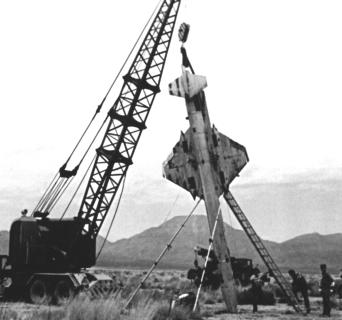Lockheed Q-5/AQM-60 Kingfisher
The Kingfisher was a target version of the U.S. Air Force's X-7 test vehicle. As such, its development began in December 1946, when the USAF requested an unmanned ramjet test vehicle for speeds up to Mach 3. Under project MX-883, Lockheed designed the Model L-151, initially designated PTV-A-1, but redesignated as X-7 in 1951. The first launch of an X-7 in April 1951 was unsuccessful, but in the following years, the X-7 successfully tested many different types of ramjet.
The X-7 was air-launched from B-29 or B-50 carrier aircraft, and was boosted to ramjet ignition speed by a single large expendable solid-fueled rocket booster attached to the vehicle's tail. An unusual feature of the X-7 was the method of recovery. A multistage parachute system slowed the drone to a descent in a vertical nose-down attitude. The nose consisted of a long spike which penetrated the ground upon impact. Therefore the vehicle literally rammed itself nose first into the desert floor, preventing damage to the rest of the airframe.
 |
| Photo: Lockheed Martin |
| X-7A-1 |
In 1954, a significantly modified version, designated X-7A-3 (the original X-7 having been redesignated as X-7A-1), was introduced. It had a redesigned wing and a new booster installation, consisting of two smaller boosters located at the fuselages sides under the wings. The new configuration allowed a semi-recessed carriage under the fuselage of the B-50 carrier, much simpler than the underwing arrangement necessary with the X-7A-1's large booster. The X-7A-3's instrumentation and control equipment was improved as well. The X-7 test program continued with the new vehicle until the final flight in July 1960. The X-7B, based on the X-7A-3, was intended to test guidance and control systems, but the program was cancelled very early in the flight test phase.
 |
 | |
| Photos: Lockheed Martin | ||
| X-7A-3 | XQ-5 (AQM-60A) | |
To satisfy the need for a very high performance target drone to test the SAM-A-7/MIM-3 Nike Ajax, SAM-A-25/MIM-14 Nike Hercules, and IM-99/CIM-10 Bomarc surface-to-air missiles, a relatively unmodified target version of the X-7A-3 was ordered by the USAF. The target, named Kingfisher, was designated by the Air Force as XQ-5, but the Kingfisher program was soon transferred to the U.S. Army, which did not use the Q-5 designator. Eventually, in June 1963, the XQ-5 was redesignated as AQM-60A.
 |
| Photo: Lockheed Martin |
| XQ-5 (AQM-60A) |
However, the performance of the Kingfisher proved to be a bit too high for the interceptor missiles, and relatively few hits were scored. This was somewhat embarrassing to the military and the manufacturers of the SAMs, and therefore political pressure played a role when the Kingfisher flight program was cancelled in the mid-1960s. Production of the X-7/XQ-5 series had ended in 1959, after 61 X-7/XQ-5 missiles of all variants had been built.
Specifications
Note: Data given by several sources show slight variations. Figures given below may therefore be inaccurate!
Data for X-7A-1, X-7A-3 and XQ-5 (AQM-60A):
| Length | X-7A-1: 9.98 m (32 ft 9 in) X-7A-3: 11.3 m (37 ft) XQ-5: 11.6 m (38 ft) | ||||
| Wingspan | X-7A-1: 3.7 m (12 ft) X-7A-3, XQ-5: 3.0 m (10 ft) | ||||
| Height | 2.1 m (7 ft) | ||||
| Diameter | 61 cm (20 in) | ||||
| Weight | 3600 kg (8000 lb) | ||||
| Speed | Mach 4.3; 4500 km/h (2800 mph) | ||||
| Ceiling | 30000 m (100000 ft) | ||||
| Range | 210 km (130 miles) | ||||
| Propulsion |
|
Main Sources
[1] Jay Miller: "The X-Planes X-1 to X-45", Midland Publishing, 2001
Back to Current Designations Of U.S. Unmanned Military Aerospace Vehicles
Back to Directory of U.S. Military Rockets and Missiles
Last Updated: 28 April 2002